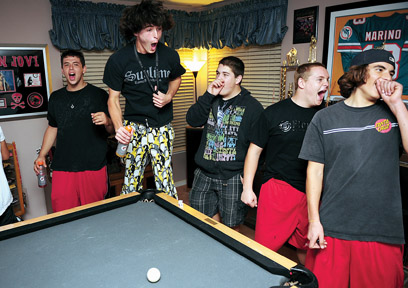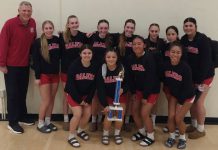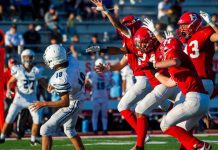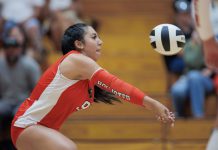
After practice on Thursday’s, the night before a game, members
of the football team converge on the home of one player (the
parents are well aware of the convergence, and have even planned
accordingly for it) to have dinner, socialize and discuss the
upcoming game. What comes out of the experience can’t necessarily
be translated into wins or losses, but head coach Chris Cameron
said the last couple of team dinners have been great. He’s noticed
the Balers have grown closer and more together, and the bonding
experience from the team dinners is one reason why.
HOLLISTER
When Chris Cameron arrived on the San Benito High School campus in 1994 to take over the reigns as varsity head football coach, even he had never heard of the concept.
“I thought, what the hell is a team dinner?” he said.
It probably wasn’t too trendy back then, and at first glance, it’s surprising that it still continues to this day.
After all, the logistics and the planning and the preparing and the effort and the money and the sheer, overall size of anything and everything that goes into orchestrating a massive team dinner would usually be enough to turn what is a storied tradition that occurs every Thursday night during the football season into a once-a-year get-together that happens once, and only once, and never again.
Those who initially put it all together — the planning and the preparing and the effort — would normally be scared off to do it a second time, let alone every week.
But the San Benito High football team — most notably, the parents and families that are able to strategize what is essentially a wedding reception every week in their homes — has kept the team-dinner tradition alive for as long as the coaching staff can recall.
“It’s pretty cool,” said Ed Schmidt, who coaches the defensive line for the Balers. “The team dinners have been going on since at least 1990.”
That’s at least 20 years of well-fed football players.
Although the origin isn’t exactly known, and the benefits can’t exactly be quantified, the team dinner is exactly what it sounds like.
After practice on Thursday’s, the night before a game, members of the football team converge on the home of one player (the parents are well aware of the convergence, and have even planned accordingly for it) to have dinner, socialize and discuss the upcoming game.
What comes out of the experience can’t necessarily be translated into wins or losses, but Cameron said the last couple of team dinners have been great. He’s noticed the Balers have grown closer and more together, and the bonding experience from the team dinners is one reason why.
“If they just show up, eat and then scram, well then it’s probably useless,” Cameron said. “But if the players do bond, then they’re getting something out of it.
“I think it brings the kids together, and that’s the biggest part of it.”
Last week, roughly 100 people invaded the home of David and Yvonne Hendricks, parents of senior fullback Cody Hendricks, for the weekly team dinner. On the menu, players and coaches enjoyed tri-tip, beans, salad, garlic bread and a Prune Bowl-themed cake and cupcakes.
In hindsight, it was the perfect mix of protein, carbohydrates and fiber, as the Balers eked out a 34-32 victory against Gilroy just 24 hours later.
But the planning and the preparing and the effort by the Hendricks’ began months ago, just after they signed up to host the dinner with Rich and Liz Hunter, parents of tight end Jake Hunter, at the beginning of the year.
It was the second time in as many seasons the Hendricks have hosted the event.
“You’ve never seen people eat so much in your life,” David said.
“The whole team is invited and all the coaches are invited,” he added. “Sometimes they come and sometimes they don’t.”
There is a ballpark figure for how many are expected to show up. Of course, when tri-tip is on the menu, one should expect a full football team and then some.
“Last year we did tri-tip and they were all excited,” Yvonne said.
The Hendricks began “stockpiling” the tri-tip in their freezer after Labor Day — “We have a big freezer,” Yvonne said — taking advantage of sales and discounts along the way. Trying to calculate the amount of food needed to feed about 100 people, though — at least 73 of whom are hungry football players — calls upon simple, mathematical equations passed down from previous team dinners, and from mother to mother.
Yvonne said she received help from Lynn Jacobson, mother of former Haybaler and Washington State left guard Wade Jacobson, who lent some trusty advice: 10 players per loaf of French bread, one player per pound of tri-tip.
“It’s fun. I like to do it,” Yvonne said. “It’s like an all-day event, getting everything together.”
And the numbers are somewhat staggering, although perhaps what you’d expect for a hungry football team.
One hundred pounds of tri-tip.
Fifteen loaves of French bread.
Seven gallons of beans.
Eighteen pounds of salad.
Five pounds of butter.
Ninety Gatorades.
Seventy bottles of water.
“And I had to go into the garage because there wasn’t enough,” Yvonne said after the beverages ran out.
There were also at least eight adults helping out with the team dinner. Along with the Hendricks and Hunters, Grandpa Dan Hendricks was present, as was Gordon, Chad and Lynn Jacobson, who came out of team-dinner retirement to help out where they could.
“When Wade left, we were done. That was it,” quipped Gordon Jacobson, Wade’s father.
“But it really is a team effort,” he added.
Gordon was master chef of the massive event, using a grill provided by Chris Brigantino.
Nearby, several players sat at picnic benches, perhaps wanting to be first in line when the tri-tip was finally served, while inside, others competed in an intense game of billiards that included its fair share of trash-talking and poor sportsmanship — all in jest, of course.
In another room, a few players showed off their musical chops while playing Rockband, while others stared longingly at dessert in an adjacent room.
The dessert was Prune Bowl appropriate, too. Two helmet-shaped cakes pitted against one another was at the forefront on the dining room table — a San Benito helmet and a Gilroy helmet with the No. 34 for Mustang Christian Salazar, a family friend — while red-and-white cupcakes, with tiny Baler helmets positioned on top, were stacked high on the back end.
Yvonne actually purchased the mini helmets on eBay, but the helmets weren’t originally San Benito red — nor were they emblazoned with the letter “H.”
So Yvonne, who works for a local auto dealership, asked the body shop to sand each individual helmet inside and out, then spray-paint it red. Another friend, who works for a graphic designer, then made the “H” decals for each side of the helmet.
“They were quite expensive little helmets, let me tell you,” she said.
Aside from having 70-plus football players at your house, though, the helmets were about as football-related as the team dinner would get.
Interestingly enough, last week’s get-together — and this is supposedly the case for nearly all team dinners — didn’t exactly feature football discussion.
Football players and football parents and football coaches — all with one obvious thing in common, but never really talking about it.
Although the night’s menu refrained many of the players from extended conversations about anything, there are some unofficial, unspoken rules of the team dinner — no shop talk.
“That’s at the team meeting, after the team dinner,” junior Ryan Di Salvo said. “Right now it’s about bonding, having fun and eating.”
The team meeting, which takes place at an undisclosed location, is where whatever is going to be said prior to a football game is actually said. The details are murky beyond that, though.
What is known is the way the team dinner ends — by the sound of a conch shell, which is passed down from player to player, year after year.
When the shell is sounded, the players help clean up, say thank you, then take off for the team meeting.
“It’s tradition,” Di Salvo said. “It’s strictly for the team.”
In other words, no coaches.
Said Cameron, “That’s the kids’ time.”









